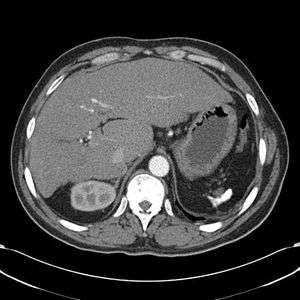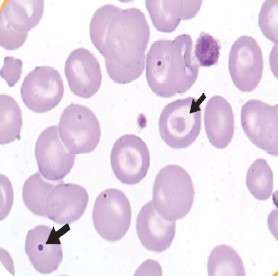Asplenic patient
Background
Causes of asplenia
- Congenital
- Prior splenectomy for:
- Previous hypersplenism
- Sickle cell disease
- Immune thrombocytopenic purpura, TTP, autoimmune hemolytic anemia
- Hodgkin's lymphoma
- Thalassemia
- Hereditary spherocytosis
- Splenic injury (rupture/hemorrhage)
- Functional
- Sickle cell disease
Clinical Features
Presentation
- Sickle-cell disease patient over the age of 8
- Absent spleen on CT
- Otherwise asplenic patient
Asplenia increases risk of (and worsens course of)
- Pneumonia
- Sepsis/septicemia
- Babesiosis, Ehrlichiosis
- Infections from encapsulated bacteria (e.g. Strep pneumo, H. influenzae, Neisseria meningitidis)
- Viral illnesses
Signs/symptoms of infection
- Cough, fever, rigors, malaise
- Nausea/vomiting, constipation/diarrhea
- Urinary symptoms
- wound infection
- Rash
- Increased oxygen requirement, tachycardia
Differential Diagnosis
- Bacterial infection (sepsis)
- Streptococcus pneumonia
- Haemophilus influenzae type B
- Neisseria meningitidis
- Capnocytophaga canimorsus
- Bordetella holmesii
- Viral illness

CT of an asplenic patient
Evaluation
Management
Sepsis
- 30mL/kg fluids
- broad spectrum antibiotics appropriate for suspected infection
- overwhelming majority of cases are from streptococcus
Fever (no sepsis)
- treat empirically with antibiotics
- amoxicillin-clavulanate: 90mg/kg amox per day in children divided into two doses; 875 mg/125 BID for adults
- cefuroxime: 30mg/kg per day in children divided into two doses; 500mg BID for adults
- levofloxacin 750 mg once daily (adults or adolescents only)
- moxifloxacin 400 mg once daily (adults or adolescents only)
- gemifloxacin 320 mg once daily (adults or adolescents only)
Vaccination management
- 4 doses of PCV13 before 15 months
- PPSV23 at least 8 weeks after last PCV13, first at age 2
- 2nd dose of PPSV23 3 years after first
- (if patient is >6years and has not received PCV13 or PPSV23, dose 1 time with PCV13 then dose with PPSV23 8 weeks later)
- (if patient is >6years but <18 years and has not received PCV13 but has received PPSV23, dose 1 time with PCV13 at least 8 weeks after last PPSV23)
- (if patient is >18 years and has not received PCV13 but has received PPSV23, dose 1 time with PCV13 at least 1 year after last PPSV23)
- Redose PPSV23 every 5 years
- Hib conjugate vaccine for all unvaccinated patients above the age of 5 years
- inactivated influenza vaccine yearly
- Neisseria meningitidis vaccine for asplenic adults[1]
Prophylaxis
- Daily Penicillin VK or amoxicillin
- for children up to age of 5 or for 1 year following splenectomy
- potentially up to age of 18 for highly immunocompromised individuals[2]
Disposition
- Based on presenting complaint/illness (asplenia by itself is not an indication for admission)
- Consider admitting asplenic patients presenting with fever
See Also
External Links
References
- Pasternick, Mark S et al. Prevention of sepsis in the asplenic patient. Uptodate. 2016.
- Lorry G. Rubin, M.D., and William Schaffner, M.D. N Engl J Med 2014; 371:349-356July 24, 2014DOI: 10.1056/NEJMcp1314291
This article is issued from
Wikem.
The text is licensed under Creative
Commons - Attribution - Sharealike.
Additional terms may apply for the media files.
